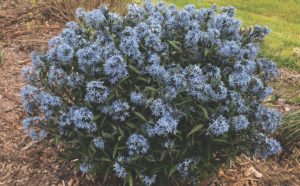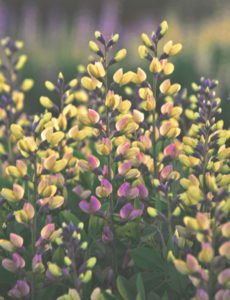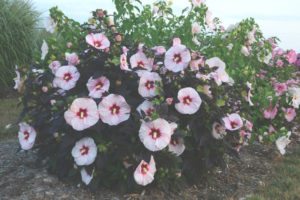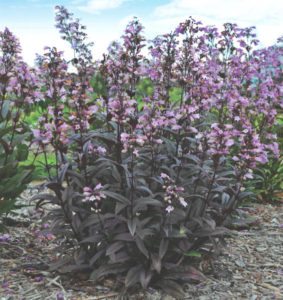Where the Wild Things Are From: An Overview on Natives and Native Cultivars
While non-native plants are not inherently bad (some are invasive, but most are not), populating gardens with native plants definitely has benefits. Since they are “local,” they are more likely to be lower maintenance as they are accustomed to your environment. With expanded cultivation, native doesn’t mean boring anymore. Here are some examples of genera that have made significant advancements.
Amsonia

Amsonia (Blue Star), has been around for a long time. Perhaps it’s Amsonia hubrichtii, native to Oklahoma and Arkansas, which is best known for its brilliant fall color and needle-like leaves. Amsonia tabernaemontana covers the most ground with its natural habitat — as far south as Florida all the way up to New York. Many of the varieties listed in this article are classified as native cultivar, or intentionally hybridized from native species. ‘Storm Cloud’, however, is a true native since it was found in the wild of Alabama and introduced directly to the market. ‘Storm Cloud’ emerges with intensely dark shoots. By the time it’s fully emerged, periwinkle blue, star- shaped flowers cover the shrub-like habit of silver-veined, dark green leaves.
Aruncus
The extent of the native range for aruncus (Goat’s Beard) is pretty wide. Our northern friends in Canada will see some in the wild, and it continues all the way down to the Southeast United States. Astilbe continues to be a popular perennial for shade, and although there are native species, most of the varieties on the market are not native to North America. Astilbe is notoriously fickle to heat and drought, two conditions that are prevalent in North American summers. Aruncus is a great native substitute: it has a similar wispy flower look, great shade performance, and is drought tolerant once established. ‘Chantilly Lace’ is a brand new variety for the market. It’s taller than Aruncus aethusifolius and shorter than Aruncus dioicus and the market standard ‘Misty Lace’.
Baptisia

Baptisia (False Indigo) has been making a serious comeback in the last few years, but it’s still not quite a household name. However, having one in your yard definitely attracts a lot of attention when it starts blooming! Before some of the recent introductions, you could expect to find these wonderful, long-lived, shrub-like plants in hues of blues, yellows, or whites and scattered across the Eastern United States from Texas to New England. Now, we’re fortunate enough to enjoy many different hues, such as the brand new bicolor ‘Decadence Deluxe Pink Lemonade’. This new baptisia opens light yellow and turns dusty raspberry purple with age, displaying both colors at the same time.
Coreopsis
Coreopsis (Tickseed) has a number of popular species, most notably C. vertillicata thanks to the old standby ‘Moonbeam’. ‘Moonbeam’ has been around for centuries and doesn’t seem to be fading in popularity. The species C. vertillata is native mostly to the Southeastern U.S. but grows mostly everywhere. It’s popular due to its long bloom time and drought tolerance. The species has grown in the past couple of years from just shades of yellow to include reds, oranges and pinks, and all are hardy to Zone 5. The Sizzle & Spice series includes all four of those colors with ‘Crazy Cayenne’ (orange), ‘Curry Up’ (yellow with red eye), ‘Hot Paprika’ (red) and ‘Zesty Zinger’ (pink).
Huechera
Some people have complained that the heuchera (Coral Bells) market is now flooded, but that hasn’t stopped its popularity with consumers. Gardeners are familiar with the genus and love the wide range of color and its versatility between sun and shade. The most popular species on the market are probably Heuchera americana (Eastern U.S.), Heuchera micrantha (Western U.S.), Heuchera sanguinea (New Mexico, Arizona, Pennsylvania), and Heuchera villosa (Eastern U.S.).
Most of the heuchera on the market are complex crosses of many different types of species and get their characteristics from them. Heat and humidity tolerance and large leaves are attributed to Heuchera villosa. Intense flower colors in pinks and reds tends to come from Heuchera sanguinea. ‘Primo Black Pearl’ and ‘Dolce Appletini’ are two great examples of different directions that heuchera can go. ‘Black Pearl’ (H. villosa hybrid) has shiny, thick, jet black leaves and a vigorous, large habit. ‘Appletini’ (H. sanguinea hybrid) is a smaller version of heuchera with fantastic fire engine red flowers and chartreuse yellow leaves. There are definitely lots of options for the garden from this popular plant category.
Hibuscus
Hardy hibiscus (Rose Mallow) has been in horticulture production for many years, and yet you still find home gardeners who seem surprised that these hibiscus are cold hardy. It’s true: there’s a few different types of hibiscus. Tropical hibiscus (Hibiscus rosa-sinensis) is native to East Asia and is probably the plant most people think of when they hear the word “Hibiscus.” Rose of Sharon (Hibiscus syriacus) is another Asian plant that behaves like a shrub.

Most of the herbaceous, hardy hibiscus can trace lineage to Hibiscus moscheutos, which is native to the Eastern U.S., venturing in a little to the Southwest. Modern crosses include a number of other different species, which all have a few things in common: they’re all native to the Southeast and they all like it hot and wet. Modern hibiscus breeding has come a long way from the massive 5-foot plants of old (like ‘Lord Baltimore’ or the more recent ‘Summer Storm’) to now a more manageable height. ‘Perfect Storm’ is a recent introduction that only stands at 3 feet, but still has the same great dinner plate flower size that gardeners desire.
Monarda
Another topic that goes hand in hand with the discussion of natives is pollinators. Not all pollinator-friendly plants are natives, but it plays into that same conservationist mentality and concern. The common name for monarda is Bee Balm, a pretty obvious clue that bees love this plant. Older varieties of monarda, like ‘Gardenview Scarlet’ and ‘Jacob Cline’, towered in the garden, leading to a wave of more compact varieties. Recently, the new trend has been regaining that height while still maintaining a dense, compact shape. ‘Rockin’ Raspberry’ gets about 20 inches tall and produces lovely dark raspberry purple flowers on very dark green leaves. Monarda is native to the Eastern U.S.
Panicum
Native grasses, such as panicum (Switch Grass), are a hot topic even within the native plant conversation. That’s because a number of genus of ornamental grasses can be invasive, especially in the South, such as miscanthus or imperata. Panicum virgatum, in contrast, is a commonly found grass in the North American prairie but is native to most of North America, except the most Western states. It has the height and upright nature that makes it easy to substitute for miscanthus. ‘Totem Pole’ is a new variety that has a tall, columnar shape and is great for small spaces in the garden that still need height.
Penstemon

Penstemon (Beardtongue) is a very large genus with a lot of genetic diversity. White, pink, orange and yellow flowers, all come in various sizes and shapes. It’s almost hard to believe that different plants belong to the same genus if not for the tube-shaped flower. Different species can be found across the U.S. and Mexico, and are known for being heat and humidity tolerant. One of the more interesting developments for penstemon has been in the Penstemon digitalis class, an Eastern U.S. native. ‘Blackbeard’ is an example of an improved dark foliage penstemon, with lilac purple flowers and an upright habit of deep eggplant purple leaves.
This is just a sampling — the North American continent is rich with native species and cultivars to choose from, each with their own unique history.
For more information about natives and to view regional maps, go to https://plants.usda.gov.


 Video Library
Video Library 




















